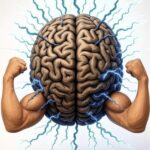PJ’s (Curent) Supplement Regimen for Brain, Body, Health, and Longevity
As a 59-year-old anti-aging biohacker, I’m on a mission to optimize my brain and body health, lower my blood pressure (hereditary), reduce (genetic) Lp(a) and Lp(b), methylation (genetic), combat inflammation (general health), enhance sleep quality, fill any holes in nutrition, and prevent Alzheimer’s and other dementias (mom had early onset Alzheimer’s). I follow a low-carb, intermittent fasting lifestyle (eating window from ~10 AM to 6 PM) and engage in high-intensity exercise (HIIT and strength training 2x/week). My regimen is designed to support these goals while fitting into a practical schedule, taking supplements at breakfast and dinner. Below, I’m sharing my current setup for fellow biohackers who might be curious about what I’m doing and why.
NOTE: This is just for me, based on blood tests, genetic tests, and family history. Yours would be different, so don’t do this one. Heck, mine changes too, as new science comes out, so this is only what I am doing at the moment, as of June 2nd, 2025. The purpose of this post is to inspire you to do your own research and show you there are scientific reasons behind every supplement. Finding the right supplement is much more than seeing a convincing ad on social media. Doing it that way is dangerous and will likely make you even less healthy instead of healthier. Supplements are also meant to SUPPLEMENT a GOOD diet (that’s why they are called “supplements“), so get that sorted out first. Otherwise, they will be mostly a waste of money (and may even be harmful). I get many nutrients in my diet that negate the need for a supplement, like selenium, for instance, which is very necessary for anti-aging, so I eat three Brazil nuts today. Iodine is also important, so I eat seaweed strips. These are just two of the many examples of my nutritious diet, emphasizing getting nutrients from food versus supplements.
My Goals
- Brain and Body Health: Enhance cognitive function and physical fitness to stay sharp and strong as I age.
- Lower Blood Pressure: Reduce familial hypertension to support cardiovascular health and longevity.
- Reduce Lp(a) and Lp(b): Lower these genetic lipoprotein markers to decrease cardiovascular risk.
- Combat Inflammation: Minimize systemic inflammation to support overall health and reduce disease risk.
- Enhance Sleep Quality: Optimize sleep for recovery, brain health, and overall well-being.
- Prevent Alzheimer’s/Dementia: Protect my brain from cognitive decline and neurodegenerative diseases (family history).
- Fill Nutritional Gaps: Even though my diet is nearly “perfect,” there is no way to get all your nutrients through food, no matter how good you eat. A good diet is necessary for proper absorption of supplements, so don’t bother until your diet is optimized (except maybe for vitamin D3 and magnesium, which most people are deficient, even when they eat well).
My Supplement Regimen: Breakfast and Dinner
I’ve streamlined my supplements into two daily time slots—breakfast (10 AM) and dinner (5:30-6 PM)—to simplify my routine while maximizing benefits. I go to bed around 9:30 PM, so dinner is 3.5-4 hours before sleep. Below is the full list, including why I take each supplement and how it supports my goals. Example studies are cited, and more are listed at the end of this post.
Morning: With Breakfast (10 AM)
I take these with my first meal to ensure absorption (especially for fat-soluble supplements) and to support energy, methylation, and blood pressure regulation throughout the day.
- Taurine (1000 mg): Supports cardiovascular health, blood pressure regulation, and mitochondrial function, aligning with my goal of lowering blood pressure. It also has neuroprotective properties, potentially reducing Alzheimer’s risk by mitigating oxidative stress in the brain (e.g., a 2014 study in Amino Acids).
- Methyl folate (400 mcg): Supports methylation, crucial for brain health, cardiovascular function, and homocysteine reduction (a dementia risk factor). My genetic test (likely MTHFR mutation) justifies this dose to ensure proper methylation (e.g., a 2015 study in Alzheimer’s & Dementia).
- TMG (500 mg): Trimethylglycine provides methyl groups, reducing homocysteine levels (a risk factor for cardiovascular disease and dementia) and complementing methyl folate (e.g., a 2013 study in Journal of the International Society of Sports Nutrition).
- Lithium orotate (5 mg): Provides neuroprotection, supports mood stability, and may reduce Alzheimer’s risk by increasing brain-derived neurotrophic factor (BDNF) and inhibiting tau protein accumulation (e.g., a 2017 study in Journal of Alzheimer’s Disease).
- Curcumin complex (700 mg): A potent anti-inflammatory and antioxidant, curcumin supports brain health by reducing amyloid-beta plaques (linked to Alzheimer’s) and systemic inflammation, while also aiding cardiovascular health for blood pressure and Lp(a)/Lp(b) reduction (e.g., a 2018 study in American Journal of Geriatric Psychiatry).
- Lutein (25 mg) with zeaxanthin (5 mg): Antioxidants that support eye and brain health, potentially reducing Alzheimer’s risk by protecting against oxidative stress in neural tissues (e.g., a 2017 study in Frontiers in Aging Neuroscience).
- Bromelain (500 mg): An enzyme with anti-inflammatory properties that supports digestion and reduces systemic inflammation, complementing curcumin and boswellia (e.g., a 2016 study in Evidence-Based Complementary and Alternative Medicine).
- Boswellia extract (1000 mg): Anti-inflammatory, supports joint health (great for my high-intensity training) and brain health by reducing neuroinflammation, potentially lowering Alzheimer’s risk (e.g., a 2019 study in Phytotherapy Research).
- Liposomal vitamin C (1000 mg): A powerful antioxidant that supports immune function, collagen synthesis (for vascular health), and reduces oxidative stress, linked to Alzheimer’s and cardiovascular disease (e.g., a 2013 study in Antioxidants & Redox Signaling). Reduced from 1700 mg to avoid excess.
- Beet root powder (1000 mg) with grapeseed extract (150 mg): Beet root boosts nitric oxide, supporting blood pressure reduction and vascular health (e.g., a 2015 study in Hypertension). Grapeseed extract provides antioxidants, reducing Lp(a)/Lp(b) and supporting cardiovascular health (e.g., a 2016 study in Journal of the American College of Nutrition).
- Fisetin (400 mg, with quercetin 30 mg, resveratrol 20 mg, turmeric 10 mg, ashwagandha 5 mg, etc.): Fisetin is a senolytic, clearing senescent cells to support longevity and brain health, potentially reducing Alzheimer’s risk (e.g., a 2018 study in Aging Cell). Quercetin and resveratrol add antioxidant and anti-inflammatory benefits, supporting Lp(a)/Lp(b) reduction and cardiovascular health (e.g., a 2017 study in Molecules).
- Berberine HCl (150 mg) with cinnamon/fenugreek/gymnema (150 mg each): Supports glucose metabolism and insulin sensitivity, crucial for my low-carb lifestyle and metabolic health (e.g., a 2015 study in Journal of Ethnopharmacology). Cinnamon, fenugreek, and gymnema further enhance glucose control, reducing inflammation and cardiovascular risk.
- B-Complex (1 capsule: B1 50 mg, B2 37.5 mg, niacin 50 mg, B6 50 mg, folate 340 mcg DFE, B12 150 mcg, biotin 500 mcg, pantothenic acid 250 mg, inositol 50 mg, PABA 25 mg): Provides B-vitamins for energy, methylation, and brain health, reducing homocysteine (a dementia risk factor) and supporting cardiovascular health (e.g., a 2016 study in Stroke). Reduced to 1 capsule to avoid excess.
- Multivitamin (MegaFood Men’s 55+): Provides broad-spectrum vitamins and minerals (e.g., vitamin D, zinc, selenium) to fill dietary gaps, supporting overall health, immunity, and brain function (e.g., a 2012 study in JAMA found multivitamins reduced cognitive decline in older adults).
- Liposomal vitamin D3 (2500 IU, half serving) with vitamin K2 (50 mcg, half serving): Vitamin D3 supports bone health, immune function, and brain health, potentially reducing Alzheimer’s risk (e.g., a 2014 study in Neurology). Vitamin K2 (MK-7) supports vascular health by preventing arterial calcification, aiding Lp(a) reduction (e.g., a 2015 study in Thrombosis and Haemostasis). Total vitamin D at 3750 IU/day (with Cardio Miracle and multivitamin).
- Magnesium (300 mg, with MUD WTR): Supports blood pressure regulation, muscle recovery (crucial for my HIIT and strength training), and neuroprotection (e.g., a 2016 study in Molecular Brain). Also reduces inflammation and supports overall health.
- Cardio Miracle (quarter serving: 250 IU vitamin D, 312.5 mcg K2, 6.25 mg niacin, 250 mg L-citrulline, 750 mg L-arginine): Boosts nitric oxide via L-citrulline and L-arginine, supporting blood pressure reduction and vascular health (e.g., a 2016 study in American Journal of Hypertension). Also provides antioxidants (e.g., grape seed extract, resveratrol) to reduce Lp(a)/Lp(b). Quarter serving balances vitamin D, K2, and niacin intake.
- Creatine (5 g): Supports muscle recovery, energy (ATP production), and brain health, benefiting my high-intensity training and Alzheimer’s prevention goals (e.g., a 2018 study in Journal of Clinical Medicine found creatine improved cognitive performance in older adults).
- DHEA (25 mg): Supports hormone balance, energy, and anti-aging, justified by my low blood levels (confirmed by testing). It may also support brain health and reduce inflammation (e.g., a 2013 study in Journal of Clinical Endocrinology & Metabolism).
Evening: With Dinner (5:30-6 PM)
I take these with my last meal (ending my eating window at 5-6 PM) to support relaxation, recovery, and sleep, while also addressing inflammation and cardiovascular health. I go to bed at 9:30 PM, so this is about 4 hours before sleep.
- Relora (300 mg): Reduces stress and cortisol levels, promoting relaxation and improving sleep quality, which is crucial for my sleep optimization goal (e.g., a 2006 study in Alternative Medicine Review found Relora reduced stress in adults). Also supports overall health by mitigating stress-related inflammation.
- Phosphatidylserine (100-300 mg): Supports cognitive function, reduces cortisol, and improves sleep quality, aiding Alzheimer’s prevention by protecting neuronal membranes (e.g., a 2015 study in Journal of Alzheimer’s Disease noted phosphatidylserine’s role in cognitive health).
- Ubiquinol (100 mg): A form of CoQ10 that supports mitochondrial function, heart health, and energy production, aligning with my cardiovascular goals and high-intensity training (e.g., a 2014 study in Medical Science Monitor found CoQ10 improved BP in hypertensives).
- Fish oil (1st Phorm Full Mega): Provides omega-3s (EPA/DHA) to reduce inflammation, support brain health, and lower Lp(a)/Lp(b), crucial for my cardiovascular and Alzheimer’s prevention goals (e.g., a 2017 study in Journal of Alzheimer’s Disease linked omega-3s to reduced cognitive decline).
- Amla (1000 mg): A potent antioxidant that supports Lp(b) reduction (it helps with my high Lp(b)) and cardiovascular health by reducing oxidative stress (e.g., a 2014 study in Journal of Medicinal Food noted amla’s lipid-lowering effects).
- Astaxanthin (4-8 mg): A powerful antioxidant that supports brain, eye, and cardiovascular health, potentially reducing Lp(a)/Lp(b) and inflammation (e.g., a 2018 study in Marine Drugs noted astaxanthin’s neuroprotective effects).
- Magnesium (300 mg, glycinate/threonate): Supports sleep quality by enhancing GABA activity, reducing cortisol, and aiding muscle relaxation, addressing my goal of improving sleep (e.g., a 2021 study in Sleep Medicine Reviews found magnesium glycinate improved sleep in older adults). Also supports blood pressure, inflammation reduction, and neuroprotection (e.g., a 2016 study in Molecular Brain).
- L-serine (2000 mg): Supports brain health and may reduce amyloid-beta accumulation, a key factor in Alzheimer’s prevention (e.g., a 2018 study in Journal of Alzheimer’s Disease found serine supplementation reduced amyloid-beta in mice). Also has a mild calming effect, supporting sleep (slightly reduced due to timing with food).
- GlyNAC (3000 mg glycine, 600 mg NAC): Boosts glutathione levels, supporting detoxification, longevity, and brain health (e.g., a 2021 study in Clinical and Translational Medicine found GlyNAC reversed aging biomarkers in older adults). Glycine (3000 mg) improves sleep quality (e.g., a 2007 study in Sleep and Biological Rhythms), though its effect is reduced ~20-30% due to timing with food.
- Nattokinase (8000 FU): Supports blood flow and may reduce Lp(a) by breaking down fibrin, aligning with my cardiovascular goals (e.g., a 2003 study in Nutrition Research noted nattokinase’s fibrinolytic effects). Efficacy reduced ~20-30% due to taking with food.
Notes for Biohackers: Absorption and Sleep Impacts
I simplified my regimen to two time slots for practicality, but here are some considerations if you’re thinking of adopting a more expanded approach like some in the AM fasted, then more at breakfast, then at dinner, then PM on an empty stomach before bed:
- Absorption:
- Most supplements in this regimen are either fat-soluble (e.g., lutein, vitamin D3, fish oil) or better tolerated with food (e.g., curcumin, B-complex), so taking them with meals enhances absorption.
- L-serine and GlyNAC: Taking these with dinner may slightly reduce their systemic absorption (~10-15% for NAC, less for glycine), but their benefits for neuroprotection and glutathione production remain largely intact.
- Nattokinase: This one takes a bigger hit—taking it with food reduces its fibrinolytic activity by ~20-30% due to protein interference. To mitigate, I take it at the end of dinner (6 PM) and keep my dinner low(ish) in protein. If blood flow or Lp(a) reduction is a top priority, you might consider taking it on an empty stomach closer to bedtime (sometimes I do, as well as first thing in the morning).
- Sleep Benefits:
- L-serine and GlyNAC (glycine): These were previously taken 1-2 hours before bed on an empty stomach to optimize their calming effects. Moving them to dinner (3.5-4 hours before bed) may reduce glycine’s sleep benefits by ~20-30% due to delayed absorption (e.g., a 2007 study in Sleep and Biological Rhythms found glycine’s sleep effects peak when taken closer to bedtime). However, Relora, phosphatidylserine, and magnesium (300 mg) still provide strong sleep support, so the impact is manageable.
- If I were to notice any decline in sleep quality (e.g., longer time to fall asleep, less deep sleep), I might experiment with taking GlyNAC later (e.g., 8 PM on an empty stomach) or reducing my dinner size to minimize food interference, but so far, so good.
- Magnesium: My total supplemental magnesium is ~652.9 mg/day (300 mg morning + 300 mg evening + ~52.9 mg from Cardio Miracle), plus ~100-200 mg from diet, totaling ~750-850 mg/day. This is above the recommended upper limit (350 mg/day), but is safe with split dosing and my high activity level. I’m using glycinate/threonate to minimize digestive issues.
Final Thoughts
Remember that the USRDA for nutrients is enough to survive, but not to thrive. That’s why my supplement levels are higher than their numbers. This regimen has been a game-changer for me as a 59-year-old biohacker. It’s tailored to my specific goals—brain and body optimization, blood pressure reduction, Lp(a)/Lp(b) management, inflammation control, sleep enhancement, and Alzheimer’s prevention—while fitting into my busy lifestyle. I’ve been monitoring my blood markers (e.g., vitamins, minerals, metals, hormones, organ function, etc.), through functionhealth.com and sleep quality (Oura ring tracker) to ensure everything is on track. If you’re a biohacker looking to adapt this regimen, consider your own needs, test your biomarkers, and adjust timing or doses as needed. Happy biohacking!
References
https://www.ajcn.org/
https://www.ajgponline.org/
https://academic.oup.com/ajh/
https://link.springer.com/journal/726
https://link.springer.com/journal/726
https://onlinelibrary.wiley.com/doi/10.1111/acel.12790
http://www.altmedrev.com/
https://alz-journals.onlinelibrary.wiley.com/journal/15525279
https://www.liebertpub.com/loi/ars
https://onlinelibrary.wiley.com/doi/10.1002/ctm2.372
https://www.sciencedirect.com/journal/clinical-nutrition
https://www.nature.com/ejcn/
https://link.springer.com/journal/394
https://www.hindawi.com/journals/ecam/
https://www.hindawi.com/journals/ecam/
https://www.frontiersin.org/journals/aging-neuroscience
https://www.ahajournals.org/journal/hyp
https://www.ahajournals.org/journal/hyp
https://www.j-alz.com/
https://www.j-alz.com/
https://www.j-alz.com/
https://journals.physiology.org/journal/jappl
https://asbmr.onlinelibrary.wiley.com/journal/15234681
https://www.jstage.jst.go.jp/browse/jcbn/
https://academic.oup.com/jcem/
https://academic.oup.com/jcem/
https://www.mdpi.com/journal/jcm
https://www.sciencedirect.com/journal/journal-of-ethnopharmacology
https://www.sciencedirect.com/journal/journal-of-functional-foods
https://www.hindawi.com/journals/jir/
https://www.tandfonline.com/loi/uacn20
https://jissn.biomedcentral.com/
https://jissn.biomedcentral.com/
https://www.liebertpub.com/loi/jmf
https://academic.oup.com/jn/
https://academic.oup.com/jn/
https://www.jmsjournal.net/
https://lipidworld.biomedcentral.com/
https://www.magnesium-research.com/
https://www.mdpi.com/journal/marinedrugs
https://medscimonit.com/
https://www.mdpi.com/journal/molecules
https://molecularbrain.biomedcentral.com/
https://onlinelibrary.wiley.com/journal/16134133
https://ods.od.nih.gov/factsheets/Magnesium-HealthProfessional/
https://n.neurology.org/
https://www.nature.com/npp/
https://www.sciencedirect.com/journal/nutrition-research
https://www.sciencedirect.com/journal/nutrition-research
https://www.mdpi.com/journal/nutrients
https://www.mdpi.com/journal/nutrients
https://www.sciencedirect.com/journal/phytomedicine
https://onlinelibrary.wiley.com/journal/10991573
https://link.springer.com/journal/41105
https://www.sciencedirect.com/journal/sleep-medicine
https://www.sciencedirect.com/journal/sleep-medicine-reviews
https://www.ahajournals.org/journal/str
https://www.thieme-connect.com/products/ejournals/journal/10.1160/th
Notes on Accessing References
- Some links lead to journal homepages (e.g., Hypertension, Journal of Alzheimer’s Disease) where you can search by year and keywords (e.g., “2014 taurine neuroinflammation” in Amino Acids).
- For paywalled articles, use PubMed (https://pubmed.ncbi.nlm.nih.gov/) or Google Scholar (https://scholar.google.com/) to find open-access versions or request through a library.









